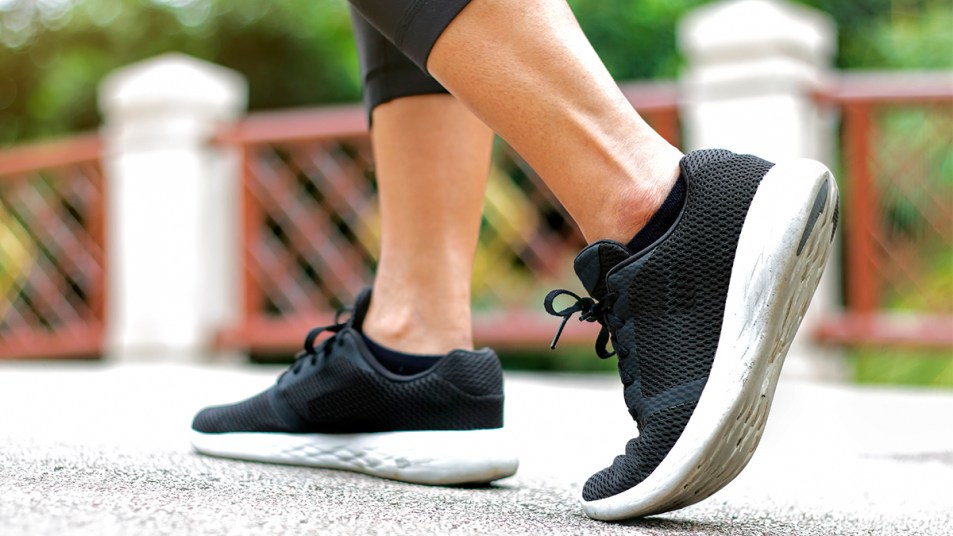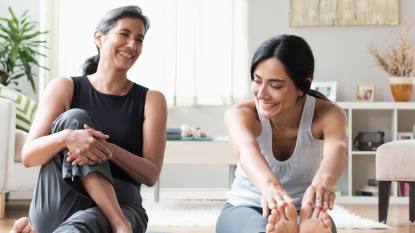Physical Therapists: More Than Half Of Us ‘Walk Crooked’ — How That Sets Us Up For Falls, Joint Pain + How To Fix It
Discover if you have an asymmetric walking pattern using your phone and the easy way to correct your gait

Walking comes naturally to us, as human beings. All we have to do is put one foot in front of the other and we’re on our way. So most of us don’t give much thought to how we walk unless we’re injured or in pain. But experts say we should pay attention to how we move from place to place because an uneven gait — otherwise known as walking asymmetry — could have surprising effects on our health and well-being.
Walking asymmetry is surprisingly common: In one study of healthy people, more than half of subjects suffered from it. That’s a problem, since walking asymmetry can increase your risk of losing your balance and falling. Equally important, “if you’re not walking evenly, it can lead to issues all up and down the body — you can get multi-joint pain, including back pain, hip pain, knee pain, foot and ankle pain,” says Erica Fritz Eannucci, PT, physical therapy manager at the Hospital for Special Surgery in New York City. “The more pain the person is in, the greater the asymmetry.”
If you have walking asymmetry, over time the effort and energy it takes for you to walk can become exponentially greater, says Eileen Duffy, PT, MPT, site coordinator of clinical education at Rush Oak Park Hospital in Oak Park, Illinois. “This increase in energy consumption negatively impacts quality of life as it often leads to less energy to participate in social and leisure activities, as well as weight gain and a decline in overall mood.”
Here’s what you need to know about walking asymmetry and how to deal with it.
What is walking asymmetry?
In a nutshell, it means that the steps you take with each leg are a bit different. It could be that there are different stride lengths between the right and the left leg, that one leg steps out more quickly or higher than the other one does or that you don’t stand on one leg for as long as the other as you stride.
The gist: “Your walking looks off-balance because what the right leg is doing, the left leg isn’t,” explains Eannucci. In some cases, walking asymmetry can even look like a slight limp or like there’s a stutter to your steps. (If you’re experiencing back pain, too, it might be a hip problem. Click through for uneven hips exercises that ease the ache.)
Amy Bastian, PhD, PT, director of the Motion Analysis Lab at Kennedy Krieger Institute examines the differences between symmetric and assymetric walking in this video:
How to know if you have walking asymmetry
You might notice it if you feel slightly off balance while you’re walking or you have a limp or stutter step. Sometimes people with a pronounced walking asymmetry feel like they’re walking diagonally or they may actually walk into things, while “others feel that it’s difficult to go up the stairs,” says Theresa Marko, DPT, founder and owner of Marko Physical Therapy in New York City and a spokesperson for the American Physical Therapy Association
But in many cases “loved ones tend to notice it before the person does,” Eannucci says.
To discover if you have walking asymmetry, you can use your smartphone to film yourself walking then slow down the video as you watch it to zero in on your gait pattern, Eannucci suggests. Or you can use a gait-analysis app on your phone (like PhysioU and StepLab). Alternatively, you can even use the Health app on iPhones to get a breakdown of your step length, speed, symmetry and other walking metrics.
Top causes of walking asymmetry
Walking asymmetry is especially common among people who have a neurological condition— such as a stroke, Parkinson’s disease, multiple sclerosis, or diabetic neuropathy — or an orthopedic injury such as an ankle fracture, osteoarthritis of the knee or hip, an anterior cruciate ligament (ACL) tear or plantar fasciitis, which causes pain on the bottom of the heel, Eannucci says. (Click through to our sister site to see how a tennis ball can ease plantar fasciitis pain.)
It also could be due to differences in leg length. Or, it could be that someone has a tight joint, muscle or fascia that leads to decreased joint mobility or range of motion while walking, explains Marko. “This happens frequently in the hips, the hip flexors or the hamstrings.”
Muscle weakness also can play a role. “Often we see walking asymmetries when one has a [muscle] weakness that does not allow one leg to function properly,” Marko notes. The most common culprits for this include weakness in the lateral hip muscles (the gluteus medius, or hip abductors), the gluteus maximus (or buttocks) and the calf muscles.
Walking asymmetry is more likely as we age
Getting older can increase the risk of developing walking asymmetry, particularly if you develop osteoarthritis or lose muscle strength in one leg. Indeed, research shows that the prevalence increases by 500% as we age. Additional research has found that women between the ages of 65 and 80 who had asymmetrical strength in their knee extensors (the quadriceps muscle group) had greater gait variability and asymmetry — and their walking asymmetry increased when they pushed their pace faster.
Another age-related factor: As we get older, fluid production in the joints decreases, Marko notes. Besides reducing lubrication to the joints, this loss of joint fluid “leads to decreased flexibility in the muscles, which can lead to adaptive shortening of muscles,” she explains. “These [changes] make it harder for our joints and muscles to get into a full range of motion as we walk.”
How to prevent walking asymmetry
“Because walking tolerance is a strong indicator of overall health, walking symmetry should be a priority at any age,” Duffy says. The key is to develop a good fitness regimen — with strengthening and stretching exercises as well as walking — and to stick with it regularly, experts say. Do strength-training exercises — with weights, resistance bands, or your own body weight — to develop muscle strength throughout your legs, and work on maintaining flexibility and mobility with regular stretching. (Click through for 5 exercises to strengthen your legs.)
It’s also important to make a concerted effort to manage your weight because “obesity is directly linked to the development of osteoarthritis,” Eannucci says, and osteoarthritis can lead to walking asymmetry.
“If you are developing changes in bone alignment due to rheumatoid arthritis or osteoarthritis, consult your primary-care physician or rheumatologist to discuss bracing or orthotics to support joint alignment,” Duffy advises.
How to correct walking asymmetry
As a starting point, it can help to become more mindful of your walking pattern, Eannucci says. “Try to take every stride with a heel-toe gait pattern and try to match it on both sides.”
Check out this video to learn proper walking mechanics:
It also helps to do strengthening and stretching exercises — particularly, for your quads, hamstrings and glutes (think: lunges, squats, and the like) — since walking asymmetry often stems from muscle weaknesses or imbalances. (Click through for exercises that target your glutes.)
If the asymmetry is pronounced and/or is affecting your balance, consider making an appointment with a physical therapist, a kinesiologist or a physiatrist, Eannucci advises. “It’s really about getting to the source of why you have the asymmetry.” Once a professional pinpoints the precise cause of your walking asymmetry, they can determine the best strengthening and stretching exercises to help you correct it.
It’s worth doing what you can to correct the problem so that it doesn’t take a toll on your quality of life over time. “Keep in mind these problems did not happen overnight,” Duffy says, “and they will take time and effort to correct. The investment in your health always has a positive return.”
For more articles on walking, check out these articles:
Walking This Way May Help You Burn More Belly Fat
This content is not a substitute for professional medical advice or diagnosis. Always consult your physician before pursuing any treatment plan.













